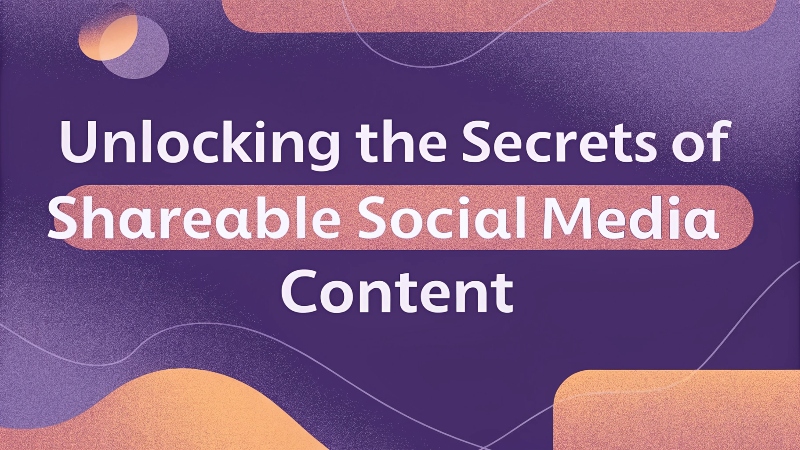
Unlocking the Secrets of Shareable Social Media Content
fast-paced world of social media, creating content that stands out and gets shared is more challenging than ever. With millions of posts competing for attention every day, understanding the science behind shareable social media content can give your brand a significant edge. This article delves into the key principles and psychological factors that make content shareable, providing insights and strategies for marketers looking to increase their content’s virality.
What Makes Social Media Content Shareable?
Shareable content is not just about being seen; it’s about resonating with your audience on a deeper level. Here are some key factors that make social media content shareable:
Emotional Appeal: Content that evokes strong emotions, whether it’s joy, surprise, anger, or sadness, is more likely to be shared. Emotions drive people to action, and sharing content is one way to express those emotions.
Storytelling: People are naturally drawn to stories. A well-crafted narrative can make your content more engaging and memorable, increasing the likelihood that it will be shared.
Relevance: Content that is relevant to your audience’s interests and needs is more likely to be shared. Understanding your audience’s preferences and tailoring your content to meet their needs can significantly increase its shareability.
Value: Providing valuable information, whether it’s educational, entertaining, or inspirational, makes your content more shareable. People are more likely to share content that they believe will benefit others.
Visual Appeal: Visual content, such as images and videos, is more likely to be shared than text-based content. Eye-catching visuals can grab attention and make your content more appealing.
Simplicity: Simple, easy-to-understand content is more likely to be shared. Complex or convoluted content can overwhelm your audience and reduce the likelihood of it being shared.
Psychological Factors Behind Shareable Content
Understanding the psychological factors that influence sharing behavior can help you create more shareable content. Here are some key psychological factors to consider:
Social Currency: People share content that makes them look good or smart. Creating content that enhances your audience’s social currency can increase its shareability.
Triggers: Content that is top-of-mind is more likely to be shared. Creating content that is triggered by everyday occurrences or popular trends can increase its visibility and shareability.
Emotion: As mentioned earlier, emotions play a significant role in sharing behavior. Creating content that evokes strong emotions can increase its likelihood of being shared.
Practical Value: People share content that they find useful or valuable. Creating content that provides practical advice or tips can increase its shareability.
Scarcity: Limited-time offers or exclusive content can create a sense of urgency, encouraging people to share it before it’s too late.
Strategies for Creating Shareable Social Media Content
Creating shareable social media content requires a strategic approach. Here are some strategies to help you create content that resonates with your audience and gets shared:
Know Your Audience: Understanding your audience’s interests, needs, and preferences is crucial for creating shareable content. Use data and insights to tailor your content to your audience’s preferences.
Use Emotional Appeal: Tap into your audience’s emotions by creating content that is relatable, inspiring, or entertaining. Emotional content is more likely to be shared.
Tell a Story: Use storytelling techniques to make your content more engaging and memorable. A well-crafted narrative can capture your audience’s attention and encourage them to share your content.
Provide Value: Offer valuable information, tips, or advice that your audience can use or enjoy. Valuable content is more likely to be shared.
Use Visuals: Incorporate eye-catching visuals, such as images, videos, or infographics, to make your content more appealing. Visual content is more likely to be shared than text-based content.
Keep It Simple: Avoid complex or convoluted content. Simple, easy-to-understand content is more likely to be shared.
Create a Sense of Urgency: Use limited-time offers or exclusive content to create a sense of urgency. People are more likely to share content that they perceive as valuable or scarce.
Measuring the Success of Your Shareable Content
To gauge the success of your shareable content, track key performance indicators (KPIs) such as:
Shares: The number of times your content has been shared.
Engagement: Likes, comments, and other forms of interaction with your content.
Reach: The number of unique users who have seen your content.
Click-through rate (CTR): The percentage of people who click on a link in your content.
Conversion rate: The percentage of people who take a desired action after interacting with your content.
By analyzing these metrics, you can gain valuable insights into the effectiveness of your shareable content and make data-driven decisions to optimize your strategy.
Creating shareable social media content requires a deep understanding of your audience and the psychological factors that influence sharing behavior. By incorporating emotional appeal, storytelling, relevance, value, visual appeal, and simplicity into your content, you can increase its shareability and drive greater engagement. Remember to track your KPIs and analyze the data to continually refine your strategy and create content that resonates with your audience.